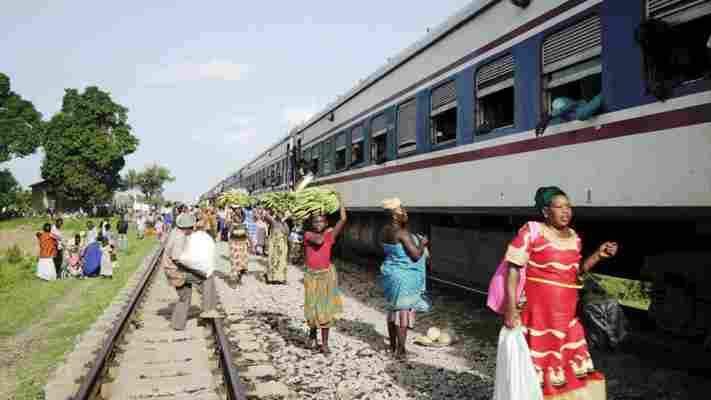Article continues below

(Credit: Thomas Lewton)
In 1970, the independence leaders of Tanzania and Zambia started building the TAZARA railway, also known as the Uhuru Railway. It cut a path from Tanzania’s port city of Dar es Salaam to the copper belt in central Zambia. Presidents Julius Nyerere and Kenneth Kaunda hoped to pave free passage for their people and goods away from then white-controlled Southern Rhodesia (today Zimbabwe) and South Africa. They called it the Freedom Railway.

(Credit: Thomas Lewton)
Today, the railway remains a lifeline to the hundreds of communities that lie along its embankments. Farmers growing maize, rice and tomatoes shuttle their produce to market in towns and cities, while traders return with consumer goods. Because of the railway, small villages have grown into big towns. For many Tanzanians and Zambians, the Kilimanjaro Ordinary Train, one of TAZARA’s three passenger trains, is the only cheap and safe means of transport.

(Credit: Thomas Lewton)
The train is a market in its own right. At each of its 100-odd stops, passengers lean out to buy huge bunches of bananas and squeeze them in through the narrow windows. Traders try their luck in the corridors, peddling plastic sandals and soft drinks.
(Credit: Thomas Lewton)
The TAZARA Station stands amid a patchwork of tin roofs on the outskirts of Dar es Salaam. And while cracks are appearing in the decades-old facade, little seems to have changed since the building was constructed. In front of swinging wooden doors, inspectors punch ticket stubs, while big cargo items like sofas and bed frames are weighed at the parcel depot below. At 13:00 sharp, the platform gates are opened and the crowds rush forward in the hope of grabbing a window seat.
(Credit: The Africa Image Library/Alamy)
On departure, the train accelerates out of Dar es Salaam and through tropical farmland, entering the Selous Game Reserve just as the sun sets. There are glimpses of wildebeest and baboons among the undergrowth before night takes hold, but travellers are told that, in the darkness, hyenas and giraffes are not far away. Passengers and workers also tell tales of elephants stopping the train in its tracks.
Tazara Ambient Landscape
The scene upon waking is surprisingly different. Mist blankets a temperate forest while the train meanders around steep hills and across deep valleys. During the night, the train has risen some 600m as it pushes to the Great Rift Valley. During construction, this presented TAZARA’s engineers with their greatest challenge. Workers had to blast holes through the biggest mountains with dynamite.
SLIDE 7b
In 1964, landlocked Zambia (then called Northern Rhodesia) gained independence from Britain and took back control of the nation’s mineral wealth. Yet its neighbour, Southern Rhodesia, turned hostile, imposing heavy duties on copper being transported to Africa’s southern ports. And so in the name of pan-African socialism, Presidents Kaunda and Nyerere agreed to build the Uhuru Railway and pave economic freedom for Zambia to the north.
SLIDE 8b
Chairman Mao Zedong offered a $400 million loan to build the railway, and soon tens of thousands of Chinese railway workers made their way to East Africa. This was China’s first major engineering project in Africa; today, the Asian country is constructing railways in almost every East African nation – amid criticisms of neocolonialism and secretive loans that saddle developing countries with debt.
(Credit: Thomas Lewton)
The train pushes relentlessly on, peaking at 1,800m above sea level in the sparse, cool hills around the Tanzanian city of Mbeya, before a steep descent across the Zambian border. While the railway was built with economics in mind, the service means much more to families living along the line. Whether ferrying children to school or taking mourners to a funeral, these communities have depended on the railway for more than 40 years.
(Credit: Thomas Lewton)
Sadly, the aging service is in jeopardy. Derailed or abandoned wagons are scattered along the length of the line. “You have to keep yourself awake and thinking nicely,” said Charles Siame as he accelerated the diesel locomotive away from the station platform. He’s been driving since 1983, but since then, the railway has started to crumble. “We’ve been restricted to run at 40km per hour due to some problems with the coaches.”
(Credit: Thomas Lewton)
Tools have been laid aside in many of TAZARA’s warehouses as workers wait on funds and equipment. Inside one dimly lit workshop, mechanics were grinding down and realigning carriage wheels – often using the original Chinese-imported machines from the 1970s. Delays and breakdowns are common. “It’s getting longer to travel,” passenger Beauty Mwango said as the train inched towards Kapiri Mposhi in Zambia, the railway’s final stop.
(Credit: Thomas Lewton)
There is hope on the horizon, however, with a steady rise in passengers and cargo companies using the railway. Increased activity at Dar es Salaam port, combined with a growing confidence in the railway as a cheap and reliable alternative to road travel, is putting TAZARA back on track. This spring, the Chinese government is expected to further support the regeneration of the railway through loans and new equipment.
(Credit: Thomas Lewton)
The train slowly pulls in Kapiri Mposhi station just before 02:00, 12 hours behind schedule, a total travel time of almost 60 hours. Mwango hauls her bags inside the station before wrapping herself in a blanket and settling in for the night; her onward bus does not leave until dawn. “I’m tired, I just feel like reaching home,” she said. “I can’t wait to see my kids.”
Leave a Comment